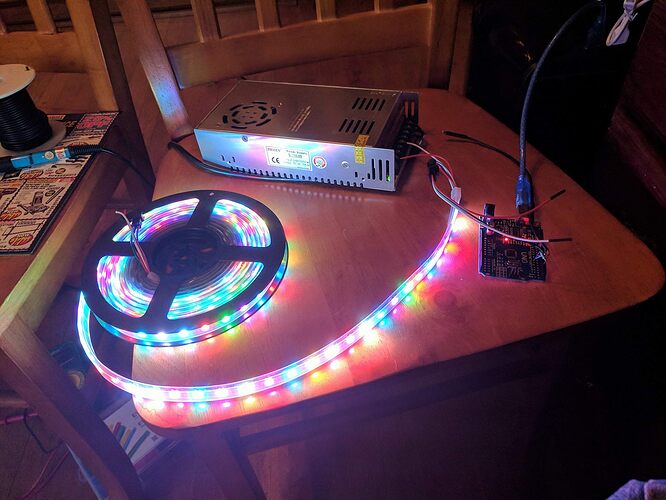Hello all,
I'm working on my first Arduino project trying to setup ambilight for my monitor. I've read countless forums here and elsewhere on google but have come to a point where I am completely out of ideas and looking for help sparking a new one!
Configuration
My project is setup using the following configuration.
Hardware:
Power Supply - https://www.amazon.com/gp/product/B0131ZJIPS/ref=oh_aui_detailpage_o02_s00?ie=UTF8&psc=1
LEDs - https://www.amazon.com/gp/product/B01H04YAHW/ref=oh_aui_detailpage_o05_s00?ie=UTF8&psc=1
Arduino Uno - https://www.amazon.com/gp/product/B01AR7YJ3O/ref=oh_aui_detailpage_o07_s00?ie=UTF8&psc=1
Software:
Ambibox screen capturing software
Arduino IDE (I've tried countless sketchs that I've found through the internet that are supposed to work with ambibox, but have also tried a sketch that is just supposed to "rainbow" the LEDs)
Wiring:
I have closely followed the configuration as shown in the below wiring diagram except I am providing no resistor for the data cable, and am connecting on pin 3 instead of pin 6: https://www.tweaking4all.com/wp-content/uploads/2014/01/arduino_no_computer_power.jpg
You may be thinking the power supply is overkill but I got it from a friend cheap (also brand new) and I plan to expand my project to have LED's supplied in the entire room...
Troubleshooting
As for troubleshooting that I have already done... I have a multimeter that I have run many tests on.
- A continuity test on the LED strip proving that my +5V, data, and GND connections are good through the entire strip. All were good except the data which failed the continuity test from one end to the other. I think this is expected as it passes when I test the data-in to an LED and then the LED to data-out. I assume this behavior is due to the LEDs are 'off' during a continuity test.
- A continuity test from the Arduino to the start of the LED strip to ensure my data connection was solid through to the LEDs
- A voltage test showing that my power supply is providing 5V at the source, all the way through the end of the LED strip, and to the Arduino uno.
Based on those tests, I can assume that all of my connections are solid and all are receiving the expect 5V of power (although wattage/amperage is unknown but I expect to be satisfactory considering the PSU is rated for 350W).
Results:
As stated earlier I have tried this with multiple different sketchs uploaded to my arduino. All provide the same result...
When I power up the unit, I can see the Arduino turn on and the power supply turn on as well. This is also the point when I can successfully get a 5V reading through my LED strip - so i assume they are also 'on'. However, none of the lights actually turn on. Initially, I thought my data connection on the first LED was bad so I experimented a bit and soldered a wire to the data-in and connected that to pin 3 on the arduino. When I do this, the LED behind it (in this case the very first LED on the strip) lights up with mostly blue, a little bit of green, and no red but is VERY dim. Noticing this, I moved my data cable to the 4th LED data-in. This time LED 3 lit up with the same pattern (also very dim). From this, I am assuming that my LEDs work, but there is a miscommunication on how they should be turned on - IE something is wrong with my data connection.
I don't know where to go from here or how else to even troubleshoot this. Has anyone run into a similar problem before? Any potential ideas will help and even if it doesn't fix the issue, might help me continue troubleshooting... But for now, I am completely stuck and don't know how to proceed. Thanks in advance ![]()


